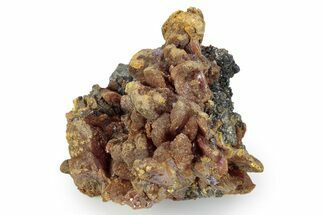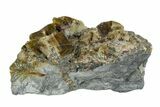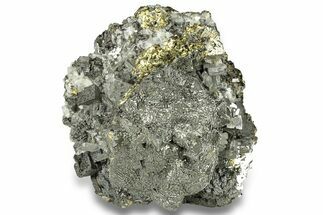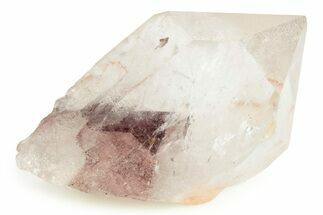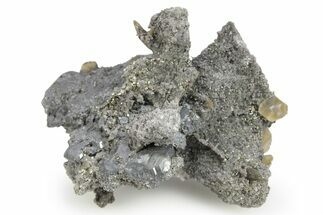This Specimen has been sold.
3.7" Siderite Crystals on Pyrite - Peru
This is a cluster of lustrous brown rhombohedral siderite crystals that formed from a pyrite and quartz crystal matrix, collected from the Julcani Mine in Huancavelica, Peru.
Siderite, also known as "chalybite", is an iron carbonate mineral that belongs to the calcite group. It can contain a wide variety of impurities, including manganese, magnesium, calcium, zinc, and cobalt. Brown hues are typical for siderite, though occasional specimens can be white and gray. It can occur as rhombohedral crystals with rounded faces, and as scalenohedral crystals in rare cases. Botryoidal, concretionary, massive, stalactitic, and mammillary are some of the more common formations of siderite.
Since siderite is such a prevalent mineral, it can be found all around the world in a wide variety of colors and formations. The Morro Velho Mine in Minas Gerais, Brazil is noteworthy for producesing beautiful gemmy siderite specimens. The crystals collected from here are often translucent yellow-green in color, and form in association with dolomite, cubanite, pyrrhotite, and chalcopyrite.
The chemical formula of siderite is FeCO3, with the variable formula including manganese, magnesium, calcite, zinc and cobalt ((Fe,Mg,Ca,Mn,Zn,Co)CO3).
Since siderite is such a prevalent mineral, it can be found all around the world in a wide variety of colors and formations. The Morro Velho Mine in Minas Gerais, Brazil is noteworthy for producesing beautiful gemmy siderite specimens. The crystals collected from here are often translucent yellow-green in color, and form in association with dolomite, cubanite, pyrrhotite, and chalcopyrite.
The chemical formula of siderite is FeCO3, with the variable formula including manganese, magnesium, calcite, zinc and cobalt ((Fe,Mg,Ca,Mn,Zn,Co)CO3).
About Pyrite
The mineral pyrite, also known as iron pyrite, is commonly referred to as Fool's Gold because its metallic luster and pale brass-yellow hue give it a superficial resemblance to gold. In the old mining days, pyrite was sometimes mistaken for gold.
It is the most common of the sulfide minerals with the chemical formula FeS2. Pyrite crystals occur in many shapes and habits, including cubes of all sizes, penetration twin cubes, pyritohedral clusters and as small druzy crystals that can exhibit a beautiful glistening effect.
The mineral pyrite, also known as iron pyrite, is commonly referred to as Fool's Gold because its metallic luster and pale brass-yellow hue give it a superficial resemblance to gold. In the old mining days, pyrite was sometimes mistaken for gold.
It is the most common of the sulfide minerals with the chemical formula FeS2. Pyrite crystals occur in many shapes and habits, including cubes of all sizes, penetration twin cubes, pyritohedral clusters and as small druzy crystals that can exhibit a beautiful glistening effect.
SPECIES
Siderite, Quartz & Pyrite
LOCATION
Julcani Mine, Julcani District, Angaraes Province, Huancavelica, Peru
SIZE
3.7" wide
CATEGORY
ITEM
#173404
 Reviews
Reviews
